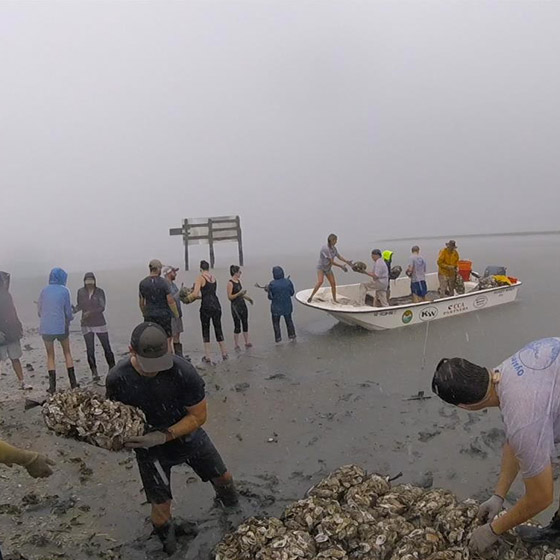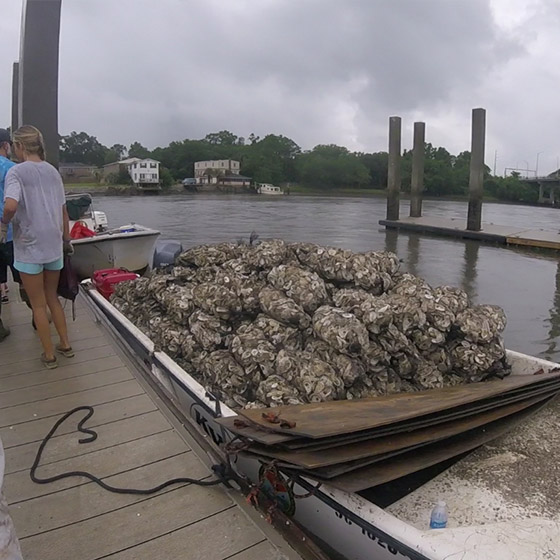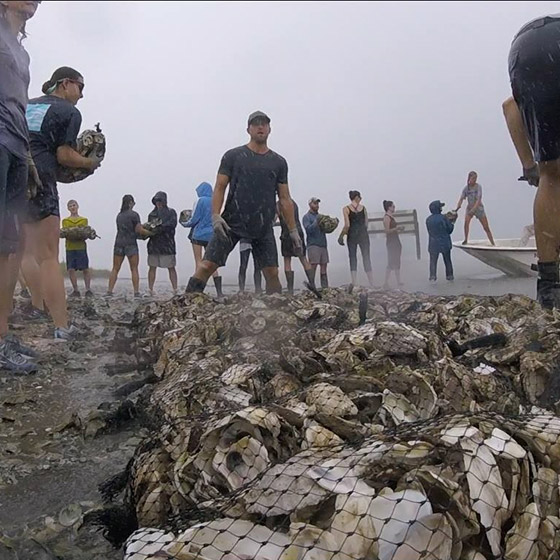
Chance to Restore What Mother Nature Lost
At first thought many people would associate oysters with restaurants or family gatherings and nights around a fire with bottles of hot sauce everywhere. But to see the journey oysters take to get to your mouth is something that will change your perspective on them entirely.
The South Carolina Aquarium recently invited me to join them in a project which required me to wear boots, sunscreen, and “protective clothes” so of course, I accepted the invitation. I listened closely to the weather forecast and assumed the event would be canceled.
Instead, I learned that we would be teaming up with the South Carolina Department of Natural Resources to help rebuild local oyster beds and as long as there is no visible lightning or imminent danger, the work goes on.
The oyster bed rehabilitation was taking place in West Ashley off of the Wappoo Cut boat landing. The day started out as any typical summer day in Charleston; overcast with a chance of rain. A briefing by the South Carolina Oyster Restoration and Enhancement (SCORE) project leader Michael Hodges explained to us the importance of the oyster bed rehabilitation project. Not only would we be helping the local culinary scene, but also the Ashley River, Cooper River and the surrounding land.
We began by unloading a flat bed truck with recycled oyster shells and forming a human chain to get these mesh bags to a skiff before it headed out to the location we would be rehabilitating. Our boat departed the Wappoo Cut and headed out to a location near the James Island Expressway and the chance of rain quickly turned in to an everlasting downpour that soaked every thread of my clothes, boots, and soul.
The torrential downpour made getting out of the boat and on to the pluff mud shoreline an exciting adventure. If you have never seen an overweight man trudge into pluff mud during low tide in Charleston, you are missing out. I pummeled towards the center of the earth faster than a smartphone dropped in the toilet.
Once I regained my footing and walked along the wooden planks that were provided, I was able to help the consortium rebuild the oyster beds quickly and efficiently. Approximately 350 bags weighing 30 pounds each were unloaded off a boat and onto the shoreline by a team of SC Aquarium and DNR volunteers.
The mesh bags of recycled oyster shells were staked down and connected to ensure all of our efforts were preserved and permanent. DNR employees took careful measurements of the layout to include the placement of the bags, location of the bags in relation to the shoreline, and shoreline erosion. These measurements will be compared to future measurements to ensure growth and stability is on target with expectations.
Once the hard work was completed, the rain subsided and the volunteers battled the pluff mud to head back to the boat that would take them away. The oyster bed rehabilitation project was done for the day, but continues to happen during the summer under most weather conditions. The work is done by a team from the SCORE program as well as many volunteers. The aquarium, which is a nonprofit organization, was able to do that because the resources were underwritten in part by a grant from the Samuel Freeman Charitable Trust and a gift from Domtar Paper Company.
Oysters not only taste good (to some people) but they also improve water quality, shore stability by controlling erosion, and the overall ecosystem by filtering out nitrogen and phosphorus leading to a more diverse fish population. The more oysters that remain in our water, the better our waters will be.
The efforts completed that day will ensure oyster larvae have a community to attach to, grow on, and recruit other oyster larvae. Each year new oyster larvae will attach to the substrate, known as cultch, and the oyster beds will grow bigger and bigger each year. Since oysters deposit a “concrete” that permanently attaches them to the cultch, they will be there until they die or are harvested.
We all can help out to improve our oyster beds and reefs thus improving our local water quality. When you are at a restaurant that serves oysters, ask them what they do with their shells. If they do not collect the shells separately and donate them to DNR, ask them why not. Recycling oyster shells is free, and it cuts down on restaurant waste weight, which reduces the cost for trash removal.
To find out more information on the South Carolina Oyster Restoration and Enhancement Project or to volunteer, visit http://score.dnr.sc.gov/ or contact Michael Hodges at This email address is being protected from spambots. You need JavaScript enabled to view it.
To find out more about the South Carolina Aquarium and their efforts to continue to protect South Carolina’s marine habitat visit scaquarium.org or contact Director of Marketing, Karen Monahan at This email address is being protected from spambots. You need JavaScript enabled to view it.




Article by Brandt Prince on behalf of ABC News 4
See original at abcnews4.com.
Photos by Brandt Prince



